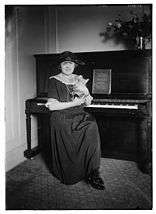Claire Dux
| Claire Dux | |
|---|---|
|
The Theatre Magazine, February 1922 | |
| Born |
Clara Auguste Dux 2 August 1885 Witkowo, Prussia (now Poland) |
| Died |
8 October 1967 (aged 82) Chicago, Illinois, US |
| Occupation | Soprano opera and concert singer |
| Spouse(s) |
Wilhelm Alfred Imperatori Hans Albers Charles H. Swift |
Claire Dux (2 August 1885 – 8 October 1967) was an operatic and concert soprano with a successful career in continental Europe, England, and the United States.
Early life
Clara Auguste Dux was born in the village Witkowo in the county of Gnesen (today Gniezno); that area was part of the Kingdom of Prussia's Province of Posen from 1815 until 1920. Alan Blyth calls her Polish,[1] other sources call her German,[2][3][4] The New York Times called her Swiss in 1920.[5] Both of her parents were musical, her mother was related to Clara Schumann.[3] At the age of 12, Dux sang Gretel in a school production of Humperdinck's Hänsel und Gretel.
Career


She went to Bromberg (today Bydgoszcz) where she started to study singing. Later she went to Berlin where she studied singing with Adolf Deppe and Maria Schwadtke, a student of Marianne Brandt, and to Milan where she studied with Teresa Arkel.[6] Dux made her professional debut in 1906 at the Cologne Opera as Pamina in Mozart's The Magic Flute. Other roles in Cologne included Mimì in Puccini's La bohème, and she gained international reputation through European tours.[6]
During a guest appearance at the Berlin State Opera in 1909, she sang Mimì opposite Enrico Caruso. From 1911 until 1918, she was a member of the Berlin State Opera. There, she sang Sophie in the first Berlin performance of Richard Strauss' Der Rosenkavalier, which impressed Thomas Beecham so much that he invited her to sing that role at the opera's first performance in London at the Royal Opera House in 1913.[4]
Dux had made her London debut in 1911 with Thomas Beecham at His Majesty's Theatre. During the years from 1918 until 1921, Dux sang mostly in concert recitals and toured the Royal Swedish Opera in Stockholm. In 1921, she became a member of the Chicago Civic Opera where she debuted as Nedda in Leoncavallo's Pagliacci; she remained there for the rest of her career, although she returned to Europe occasionally as a guest artist.
Personal life
Dux was married three times: first to a writer, Wilhelm Alfred Imperatori, then briefly to the German actor Hans Albers. In August 1926 she married Charles H. Swift, son of the founder of Swift & Company, Gustavus Franklin Swift – benefactor of the University of Chicago and the Newberry Library. The Newberry Library gained through her estate the manuscript of Mozart's "Conservati fedele". The Music Department of the University of Chicago named a professorship after her: the Claire Dux Swift Distinguished Service Professor of Music and the Humanities.[7]
Recordings
In 1925, Dux was part of one of the first opera broadcasts in Germany when the station Funk-Stunde Berlin broadcast Flotow's Martha.[6] She recorded works with Pathé, Odeon, Polydor, and Brunswick.
- Lebendige Vergangenheit, 19 arias; review at AllMusic
References
- ↑ "Dux, Claire." by Alan Blyth in Grove Music Online (subscription required)
- ↑ Scott, Michael. The Record of Singing, Holmes & Maier (1980), ISBN 978-0-8419-0599-3, p. 204. Quote: "Though she was born in Poland, her family were Germans."
- 1 2 "Claire Dux, Who Assists Lemare at Next Portland Organ Concert", Lewiston Evening Journal (9 December 1922). Quote: "She was born on Polish territory and her ancestry represents several nationalities."
- 1 2 Lebendige Vergangenheit liner notes by Alex Natan. Quote: "… it would not be correct to consider her a Polish soprano, as some writers did in her obituaries: she was of strictly German parentage."
- ↑ "Claire Dux Hurt, Friend Dies; Singer Was Soon Coming Here, The New York Times (5 July 1920)
- 1 2 3 "2 August: Claire Dux – 125th anniversary" (in German) Archived 21 November 2010 at the Wayback Machine.
- ↑ Appointment of Professor Anne Walters Robertson to the Claire Dux Swift chair
External links
- Claire Dux scrapbooks, 1918-1967 in the Music Division of The New York Public Library for the Performing Arts
- 1921 recording on YouTube, "Nur zu flüchtig" (German for "Dove sono") from The Marriage of Figaro
- "Claire Dux, soprano", leaning over large phonograph, Ann Arbor, Michigan, c. 1922
- Claire Dux (seated) with Fanny Butcher, Bobsy Goodspeed of the Arts Club of Chicago, and Gertrude Stein, 1934
- Melancholy – Portrait of Singer Claire Dux by Salvador Dalí, 1942